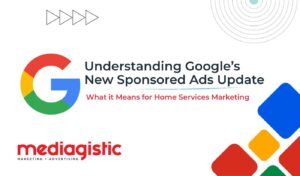Apple’s iOS 14 App Tracking Transparency Update: What We Know So Far & How it May Affect Advertisers

Apple’s iOS 14 App Tracking Transparency (ATT) update, expected to be pushed to devices in early 2021, is sure to have an impact on advertisers. The update revolves around privacy and data sharing, and while the impacts will be felt by businesses advertising on digital platforms, no one is certain to what extent.
Before moving on, the changes outlined here only apply to Apple users who are using IOS 14 – other phone manufacturers (for now) will remain unchanged. However, there are 100 million iPhone users in the United States, which accounts for roughly one-third of the nation’s total population. That means the impact still will be far-reaching. With that in mind, here’s a short recap of what we know so far and how it may affect advertisers.
“About Profit, Not Privacy”
Here is what we do know: First off, Apple made this change in a silo. A change of this magnitude, one would think, would be predicated by industry leaders collaborating on how personalized ads and privacy can coexist. However — because Apple effectively owns the data — it was judge, jury and executioner. It made the change without consulting industry leaders or seemingly any concerns on how this update will affect large or small businesses.
Before we go further, we can hypothesize why Apple made this change, and it can be summed-up in one word: Data. Data is the new gold. Apple, prior to the update, had been allowing advertisers like Facebook and Google access to its users’ data to provide a more tailored and targeting advertising experience. Now Apple is holding all the cards for itself, seemingly in an effort to use/monetize that information to its advantage.
In an official statement from Facebook, “They’re creating a policy — enforced via iOS 14’s App Tracking Transparency — that’s about profit, not privacy. It will force businesses to turn to subscriptions and other in-app payments for revenue, meaning Apple will profit and many free services will have to start charging or exit the market.”
On the surface, Apple is positioning this update to protect user privacy. You may have seen the television ads with a guy on the bus shouting “I browsed eight sites for divorce attorneys today!” Which is an extreme example, but relatable to the general public on how their browsing habits manifest into advertisements across various platforms.
What Apple is not telling the public is they will still use that data, they’re just not sharing it with the likes of Google and Facebook. So, saying the data is private is kind of like saying – we’re going to use it, just not share it with anyone else. Is that truly privacy?
“Your Data Won’t Be Shared with Anyone but Apple”
We believe users should have the choice over the data that is being collected about them and how it’s used. Facebook can continue to track users across apps and websites as before, App Tracking Transparency in iOS 14 will just require that they ask for your permission first. pic.twitter.com/UnnAONZ61I
— Tim Cook (@tim_cook) December 17, 2020
Continuing with what we know: At some point soon, Apple users will be prompted for the update and be given an option whether they’d like their data shared – we know how that’s going to go. The update should say, “Your data won’t be shared with anyone but Apple.” However, I digress.
What does that mean for advertisers? As it relates to Facebook, some of it will depend on the complexity of your campaign and your target audience. Facebook will still know a lot about you as an individual, as part of your profile you (can) tell them your gender, age, birthday, area of residence, hobbies and interests, just to name a few. If you’re advertising for a business with broad consumer interest – for example, a local beauty salon tailored to women age 24 to 55 – this change might not be significant. Conversely, a global or national brand trying to appeal to niche users may be left feeling like they were chucked overboard with their hands tied.
With the new update, advertisers will have to prioritize events on a website that they want to be tracked and optimized. Think in terms of sporting goods stores. Currently, they have a limitless ability to track events that happen on a website to optimize their advertising campaign. They can optimize for checkouts (online purchases), track what items/categories are being browsed and tailor advertising based on that information, i.e. someone looking at basketball hoops could then see similar hoops in their Facebook feed. This limitation will dramatically limit the information Facebook can receive and, therefore, use to tailor advertising messages to a user – which is significant.
For its own part, Google has announced to agencies and advertisers that it will no longer use Apple’s “identifier for advertisers” (IDFA) data in its products for advertising purposes. This is not much of a surprise because Google is sitting on mountains of first-party data of its own thanks to search data and the Chrome browser, without having to use Apple’s data.
Establishing New Norms and Resetting Campaign Expectations
Personally, I enjoy a tailored advertising experience. Yes, I’m a marketing professional and could be considered biased. But as internet technology continued to evolve throughout the 2000s, I would think back to the days of reading a Maxim magazine in college and the advertisements I’d see in there. At the time, I was the perfect demo for them, but a small fraction of the advertisements really appealed to me.
We’re never going to escape advertisements all together. So, if we are going to be shown ads, wouldn’t it make sense to at least show me items that I’m actually interested in?
Back to the beginning of the story: We don’t truly know how much this will impact campaigns, but you can expect new baselines for campaigns to emerge. Your old 2.5% click thru rate benchmark may be reduced. In the coming days, the Mediagistic team will be working feverishly to help brands transition to ATT compliance and establish new norms/benchmarks for customers to re-set campaign expectations.
So while it’s discouraging, this update shouldn’t turn into an “abandon ship” scenario as it relates to Facebook advertising. The platform has more than 2.1 billion users worldwide, and 69 percent of U.S. consumers use the platform on a daily basis. At the end of the day, that audience isn’t going anywhere. Mediagistic will continue to monitor this situation closely and keep you apprised of changes and updates as they occur.
Adam Smith is the Vice President of National Accounts at Mediagistic. He’s a driven marketing and management professional with 15+ years of experience and a passion for his work. His role requires expertise in every aspect of advertising, but also necessitates the ability to understand a business’ objectives and provide recommendations that drive results. Whether collaborating with an individual business or a marketing manager looking to drive results, the goal never changes – gain market share, increase brand awareness and make the phone ring! Connect with him on Linkedin.
Images via Thinkstock
You May Also Like

Mediagistic Announces Strategic Partnership with EGIA to Deliver Enhanced Marketing Solutions for Home Services Contractors
November 10, 2025Tampa, FL – Mediagistic, a full-service marketing and advertising agency specializing in contractors and service-based businesses, today announced a strategic partnership with… Continue Reading Mediagistic Announces Strategic Partnership with EGIA to Deliver Enhanced Marketing Solutions for Home Services Contractors…

Understanding Google’s Sponsored Results Update: What it Means for Home Services Marketing
October 20, 2025Google is once again reshaping how paid ads appear in search results, and this change (called the Google Sponsored Results Update) could… Continue Reading Understanding Google’s Sponsored Results Update: What it Means for Home Services Marketing…

Are OTT Ads Served on TV Superior to CTV Ads on Mobile Devices?
September 23, 2025As streaming continues to dominate the media landscape, advertisers face a critical question: where should their OTT ad dollars go, connected TV… Continue Reading Are OTT Ads Served on TV Superior to CTV Ads on Mobile Devices?…